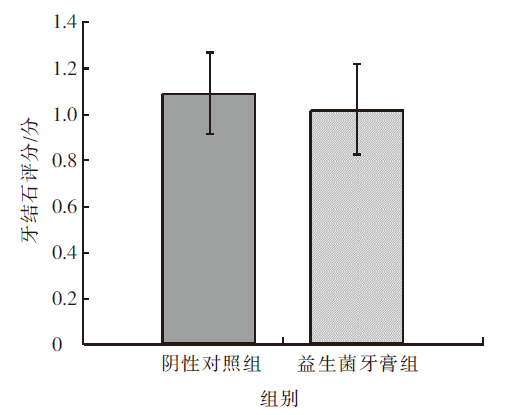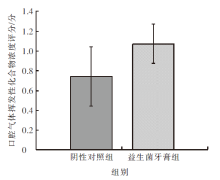畜牧与饲料科学 ›› 2022, Vol. 43 ›› Issue (5): 117-122.doi: 10.12160/j.issn.1672-5190.2022.05.019
益生菌牙膏缓解犬牙菌斑和牙结石的研究
郑智杰1,2,彭曦冉1,2,焦玉珠3,唐海丽3,陈欣雨3,张晓露3,王自力1,2,吴海冲1,2
- 1.浙江大学动物医学中心,浙江 杭州 310058
2.浙江大学动物科学学院,浙江 杭州 310058
3.上海弗艾柏生物科技有限公司,上海 200092
Efficacy Evaluation of a Probiotic Toothpaste in Relieving Canine Dental Plaque and Calculus
ZHENG Zhi-jie1,2,PENG Xi-ran1,2,JIAO Yu-zhu3,TANG Hai-li3,CHEN Xin-yu3,ZHANG Xiao-lu3,WANG Zi-li1,2,WU Hai-chong1,2
- 1. Animal Medicine Center,Zhejiang University,Hangzhou 310058,China
2. College of Animal Sciences,Zhejiang University,Hangzhou 310058,China
3. Shanghai Fiber Biotech Co.,Ltd.,Shanghai 200092,China
摘要:
[目的]评价某公司生产的一款宠物用益生菌牙膏对犬牙菌斑和牙结石形成的缓解功效。[方法]选取口腔健康、体况良好的成年比格犬10只,配对设计随机分为阴性对照组(n=5)和益生菌牙膏组(n=5);阴性对照组仅饲喂犬粮,益生菌牙膏组每次餐后给予约4 g/只益生菌牙膏,每天2次,连续使用28 d;试验第0天对所有试验犬牙齿进行洁牙抛光处理,试验第14天和第29天分别对比格犬牙菌斑进行评分,第29天对牙结石进行评分并检测口腔气体挥发性化合物(H2S+CH3SH)浓度;当牙菌斑和牙结石评分均值以及口腔气体挥发性化合物浓度均值减少幅度≥15%时,定义为益生菌牙膏效果显著。[结果]与阴性对照组相比,益生菌牙膏组在给予益生菌牙膏第14天时,牙菌斑评分均值减少幅度为-0.36%(P>0.05),第29天牙菌斑评分均值减少幅度为21.47%(P<0.05);第29天益生菌牙膏组牙结石评分均值减少幅度为6.54%(P>0.05);第29天益生菌牙膏组犬口腔气体挥发性化合物浓度均值减少幅度为-44.59% (P>0.05)。[结论]在试验期内,该款益生菌牙膏能够有效抑制犬牙菌斑的形成,但不具有减少牙结石形成和降低口腔气体挥发性化合物浓度的功效。
中图分类号:


















